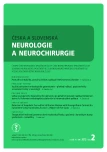Our Experience with Lateral Supraorbital Approach in Surgery of Intracranial Aneurysms
Authors:
A. Hejčl1 ,2; T. Radovnický 1; M. Sameš 1
Authors‘ workplace:
Neurochirurgická klinika UJEP a Krajská zdravotní, a. s. – Masarykova nemocnice v Ústí nad Labem, o. z.
1; Mezinárodní centrum klinického výzkumu, FN u sv. Anny v Brně
2
Published in:
Cesk Slov Neurol N 2012; 75/108(2): 203-207
Category:
Short Communication
Overview
Pterional craniotomy is one of the elementary neurosurgical approaches. Among other uses, it is applied in cerebral aneurysms of the anterior circulation. Lateral supraorbital approach developed by prof. Hernesniemi is an alternative. Compared to pterional craniotomy, it is faster and less invasive to the temporal muscle and does not limit an approach towards intracranial pathologies. We present our experience with lateral supraorbital craniotomy in patients with anterior circulation.
Key words:
lateral supraorbital approach – pterional craniotomy – intracranial aneurysm – clipping
Sources
1. Yaşargil MG, Fox JL. The microsurgical approach to intracranial aneurysms. Surg Neurol 1975; 3(1): 7–14.
2. Yaşargil MG, Antic J, Laciga R, Jain KK, Hodosh RM, Smith RD. Microsurgical pterional approach to aneurysms of the basilar bifurcation. Surg Neurol 1976; 6(2): 83–91.
3. Hernesniemi J, Ishii K, Niemelä M, Smrcka M, Kivipelto L, Fujiki M et al. Lateral supraorbital approach as an alternative to the classical pterional approach. Acta Neurochir Suppl 2005; 94: 17–21.
4. Swain RD. The surgical treatment of certain intracranial arterial aneurysms. Surg Clin North Am 1948; 28(2): 396–404.
5. Shephard RD. Operation for aneurysms of the middle cerebral artery. In: Logue V (ed). Operative Surgery. Vol 14 Neurosurgery. Philadelphia: Lippincott 1971: 172–177.
6. Kempe LG. Cranial, cerebral and intracranial vascular disease. Berlin: Springer-Verlag 1968.
7. Smrčka M, Juráň V, Gál R. A lateral supraorbital approach as an alternative to a classical pterional approach. A technical note. Neuro-ski; 23. 3. 2002; Harrachov: FN Hradec Králové, Neurologická klinika 2002.
8. Vaverka M. Finská zkušenost – zpráva z cesty. Cesk Slov Neurol N 2006; 69/102(1):79–80.
9. Vaverka M, Kikalová K, Krahulík D. Morfologická studie lamina terminalis a její klinický význam. Cesk Slov Neurol N 2006; 69/102(3): 217–221.
10. van Lindert E, Perneczky A, Fries G, Pierangeli E. The supraorbital keyhole approach to supratentorial aneurysms: concept and technique. Surg Neurol 1998; 49(5): 481–490.
11. Harland SP, Hussein A, Gullan RW. Modification of the standard pterional approach for aneurysms of the anterior circle of Willis. Br J Neurosurg 1996; 10(2): 149–153.
12. Salma A, Alkandari A, Sammet S, Ammirati M. Lateral supraorbital approach versus pterional approach: an anatomical qualitative and quantitative evaluation. Neurosurgery. In press 2011.
13. Beretta F, Andaluz N, Chalaala C, Bernucci C, Salud L, Zuccarello M. Image-guided anatomical and morphometric study of supraorbital and transorbital minicraniotomies to the sellar and perisellar regions: comparison with standard techniques. J Neurosurg 2010; 113(5): 975–981.
14. Kubo S, Takimoto H, Kato A, Yoshimine T. Endoscopic cranioplasty with calcium phosphate cement for pterional bone defect after frontotemporal craniotomy: technical note. Neurosurgery 2002; 51(4): 1094–1096.
15. Barone CM, Jimenez DF, Boschert MT. Temporalis muscle resuspension using titanium miniplates and screws: technical note. Neurosurgery 2001; 48(2): 450–451.
16. Kang SD. Pterional craniotomy without keyhole to supratentorial cerebral aneurysms: technical note. Surg Neurol 2003; 60(5): 457–462.
17. Perneczky A, Mueller-Forell W, van Lindert E, Fries G. Keyhole concept in neurosurgery. Stuttgart: Thieme 1999.
Labels
Paediatric neurology Neurosurgery NeurologyArticle was published in
Czech and Slovak Neurology and Neurosurgery

2012 Issue 2
Most read in this issue
- The Use of Percutaneous Endoscopic Gastrostomy – Overview of Indications, Description of the Technique and Current Trends in Neurology
- Postural Instability, Gait Disorders and Falls in Parkinson’s Disease
- The Algorithm of CSF Examination according to the Reccomendation of the Committee of CSF and Neuroimmunology of the Czech Neurological Society
- Obstructive Sleep Apnoe and CPAP – is it Reasonable to Solve Nasal Patency?
